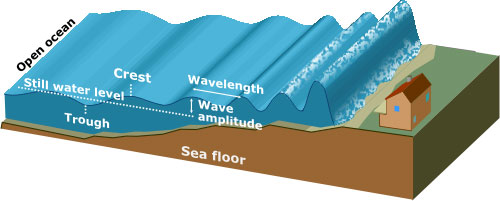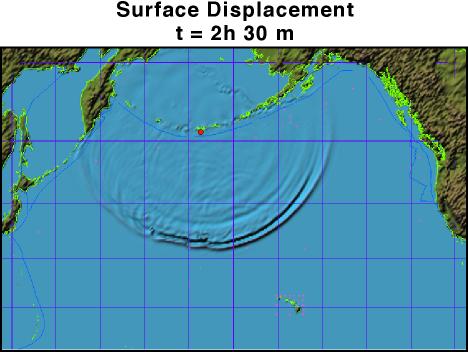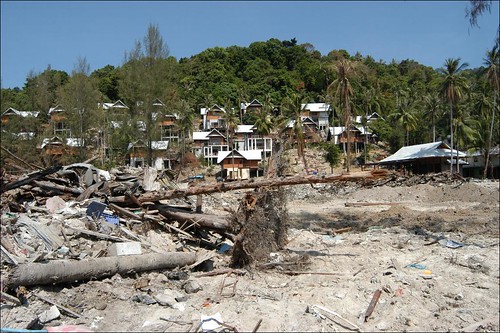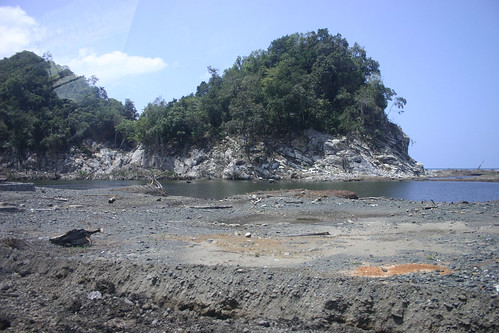13 May 2008Waves & Transference of EnergyWave is a transfer of energy, in the form of disturbance through some medium, without translocation of the medium. A wave having a short duration is called pulse. Waves that vibrate in repeating cycles illustrate periodic motion or harmonic motion. One complete oscillation is called cycle.
There are three main types of waves. These types of waves are grouped according to how they travel, or WAVE MOTION.
TYPES OF WAVES:
Mechanical waves. Mechanical waves need a material medium to travel (ropes, water, or air are examples).
These waves are divided into three different types:
Transverse waves - these waves cause the material to move perpedicular to the direction of wave travel.
Longitudinal waves - these waves cause the material to move parallel to the direction of wave travel.
Surface waves - these waves are both transverse and longitudinal waves mixed in one medium.
Electromagnetic waves. Electromagnetic waves do not require a medium to travel. Examples of this type of wae include light and radio waves.
Matter waves are produced by electrons.
So how do waves move? Waves transfer energy from a vibrating source through whatever medium it is in. For example, if you drop a pebble into a pond, you’ll make a wave that moves out from the center in an expanding circle. The water DOES NOT move. It is the disturbance that moves. After the disturbance passes, the water is exactly where it was before the wave passed. When someone speaks to you from across the room, the sound wave travels through the air as a disturbance in wave form. The air molecules themselves do not move. If the air molecules themselves moved, we would call that wind.
Mechanical waves require a medium. What is a medium? Examples include air, water ropes, a string, etc. A medium is any substance that has molecules and can transfer energy in the form of a wave. Does the type of medium have any effect on wave travel? Of course! Sound travels differently through air than it does through water. In fact, sound travels through cold air differently than it travels through hot air. A wave is just a transfer of energy from molecule to molecule, and so on and so on, until there is no more medium to transmit the wave. That energy is then reflected backward. Think of an echo - once the sound wave reaches solid ground, it can be reflected back toward its source. How well energy is reflected depends upon the density of the medium that is transferring the energy.
Whatever the medium, the speed, frequency, and wavelength of a wave are related to each other, and that relationship is described by the following equation:
Wave speed (γ) = frequency (ƒ) x wavelength (λ)This relationship holds true for all types of waves. All mechanical waves require a medium of some sort to transfer energy. Mechanical waves are divided into three types: transverse, longitudinal, and surface.
Transverse waves cause the material to move perpendicular to the direction of wave travel. Click on the diagram with the green dots. The wave will travel to the right, and so you need to make the green dots (or molecules) move up and down. (This should create right angles, for you geometry lovers out there!) Stringed instruments and waves upon the surface of liquids are transverse, as are the electromagnetic waves of light and radio.
Longitudinal waves cause the material to move parallel to the direction of wave travel. If the wave is moving to the right, you need to make the green molecules move left and right (the same direction as the wave travel).
Both of these types of waves transfer energy. Surface waves are a combination of transverse and longitudinal waves. This means that the wave needs to move left and right as well as up and down.
(PLEASE READ THESE 2 WEBS! THEY ARE REALLY GOOD.)
http://aspire.cosmic-ray.org/labs/waves/wave_basics/wave_motion.htm
http://library.thinkquest.org/27948/waves.htmlBy Fiona


















 like whoa look at her melons!
like whoa look at her melons! 






